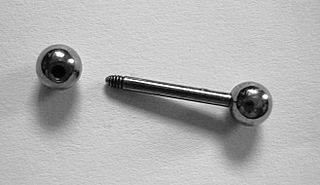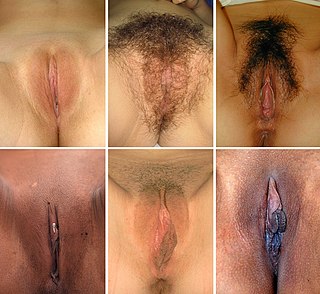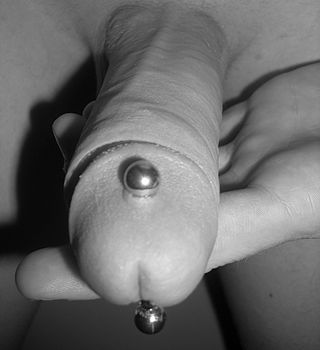
In amniotes, the clitoris is a female sex organ. In humans, it is the vulva's most erogenous area and generally the primary anatomical source of female sexual pleasure. The clitoris is a complex structure, and its size and sensitivity can vary. The visible portion, the glans, of the clitoris is typically roughly the size and shape of a pea and is estimated to have at least 8,000 nerve endings.

Orgasm or sexual climax is the sudden discharge of accumulated sexual excitement during the sexual response cycle, resulting in rhythmic, involuntary muscular contractions in the pelvic region characterized by sexual pleasure. Experienced by males and females, orgasms are controlled by the involuntary or autonomic nervous system. They are usually associated with involuntary actions, including muscular spasms in multiple areas of the body, a general euphoric sensation, and, frequently, body movements and vocalizations. The period after orgasm is typically a relaxing experience, attributed to the release of the neurohormones oxytocin and prolactin as well as endorphins.

The Prince Albert (PA) is a penis piercing which extends from the urethra to the underside of the glans. It is one of the most common male genital piercings. The related reverse Prince Albert piercing enters through the urethra and exits through a hole pierced in the top of the glans.

The G-spot, also called the Gräfenberg spot, is characterized as an erogenous area of the vagina that, when stimulated, may lead to strong sexual arousal, powerful orgasms and potential female ejaculation. It is typically reported to be located 5–8 cm (2–3 in) up the front (anterior) vaginal wall between the vaginal opening and the urethra and is a sensitive area that may be part of the female prostate.

A cock ring or cockring is a ring worn around the penis, usually at the base. The primary purpose of wearing a cock ring is to restrict the flow of blood from the erect penis to produce a stronger erection or to maintain an erection for a longer period of time. They are sometimes used as medical devices, on their own or in conjunction with a penis pump to assist in the management of erectile dysfunction. Genital adornment is another purpose, as is repositioning the genitals to provide an enhanced appearance.

In female humans and other mammals, the clitoral hood is a fold of skin that surrounds and protects the glans of the clitoris; it also covers the external clitoral shaft, develops as part of the labia minora and is homologous with the foreskin in the male reproductive system. The clitoral hood is composed of mucocutaneous tissues; these tissues are between the mucous membrane and the skin, and they may have immunological importance because they may be a point of entry of mucosal vaccines.

A frenum piercing is a type of body piercing located on the underside of the shaft of the penis. A series of parallel frenum piercings is known as a frenum ladder. A frenum ladder may be extended to include lorum piercings, hafada piercings and guiche piercings.

A dydoe is a type of male genital piercing that passes through the ridge of the glans on the head of the penis. They are often done in pairs. Less often, a "king's crown" is where several dydoes are placed around the head of the penis. The jewelry is usually a 12 gauge, straight barbell with a ball on either end, although a ring may be used at a higher chance of rejection. A deep dydoe is one that uses a longer barbell and exits near the tip of the penis.

The palang or ampallang is a male genital piercing that penetrates horizontally through the entire glans of the penis.

Genital piercing is a form of body piercing that involves piercing a part of the genitalia, thus creating a suitable place for wearing different types of jewellery. Nevertheless, the term may also be used pars pro toto to indicate all body piercings in the area of the anus, perineum, penis, scrotum, and vulva, including piercings such as anal, guiche, and pubic that do not involve perforation of genitalia. Genital piercings can be done regardless of sex, with various forms of piercings available. The main motive is beautification and individualization; in addition, some piercings enhance sexual pleasure by increasing stimulation. Pre-modern genital piercings is most culturally widespread in Southeast Asia, where it has been part of traditional practice since ancient times. Records of genital piercing are found in the Kama Sutra.

A triangle piercing is one of several forms of genital piercing applied to the vulva. It is a horizontal piercing that passes from side to side, beneath the base of the clitoral hood tissue where it meets the inner labia and under the clitoris. The name is derived from the tissue where the labia meets the clitoral hood, which looks like a triangle when pinched.

A hafada piercing is a surface piercing anywhere on the skin of the scrotum. Piercings on the scrotal raphe or "seam" of the scrotum are common. This piercing does not penetrate deep into the scrotum, and due to the looseness and flexibility of the skin in that area, does not migrate or reject as much as many other surface piercings. The main motives are beautification and individualization. A piercing that passes through the scrotum, from front-to-back, or from side-to-side, is known as a transscrotal piercing. Multiple hafada piercings are not uncommon, often as an extension of a frenum ladder or Jacob's Ladder, which is a series of piercings from the frenulum to the scrotum.

A Christina piercing, also known as a Venus piercing, is a female genital piercing. It is located where the outer labia meet, below the pubic mound. The Christina piercing is anatomy dependent; it has a high rejection rate, and is not possible for all women due to anatomical variation. If the flesh above the clitoris where the outer labia meet is fleshy enough to pinch, a Christina piercing may be successful. If the flesh in this area is too tight to pinch, a Christina piercing is contraindicated. The piercing does not facilitate sexual stimulation and can be found uncomfortable when pressure is applied. It is usually pierced with either a custom-made curved barbell or surface bar to reduce the risk of rejection.

Isabella piercing is a female genital piercing. This extremely deep clitoral shaft piercing starts below the clitoris and just above the urethra, and then goes up through the clitoral shaft and exits at the top of the hood.

Barbell style piercing jewelry is composed of a straight bar with a bead on each end, one or both beads unscrewable for removal and/or changing of the beads. Often one of the beads is fixed, either via epoxy or welding, so that only one bead is used to install or remove the jewelry. Barbell threads are usually right-handed.

A clitoris piercing is a genital piercing placed directly through the head (glans) of the clitoris itself. It is a relatively uncommon piercing by choice because of the potential for nerve damage, and because many may find it too stimulating to allow the constant wearing of a small ring or barbell. Most piercing studios will refuse to do a clitoral piercing. It is often confused with the more common clitoral hood piercing, which pierces only the hood covering the clitoral glans, allowing the jewelry to make only occasional contact with the most sensitive area.

A G-spot vibrator is a sex toy with female and male varieties. The female version of the device is built to massage the G-spot, described as a bean-shaped area of the vagina. Some women report that it is an erogenous zone which, when stimulated, can lead to strong sexual arousal, powerful orgasms and female ejaculation. The male version of the G-spot vibrator is used for massaging the prostate for both sexual and health-related reasons.

In mammals, the vulva consists of the external female genitalia. The human vulva includes the mons pubis, labia majora, labia minora, clitoris, vulval vestibule, urinary meatus, vaginal opening, hymen, and Bartholin's and Skene's vestibular glands. The vulva includes the entrance to the vagina, which leads to the uterus, and provides a double layer of protection for this by the folds of the outer and inner labia. Pelvic floor muscles support the structures of the vulva. Other muscles of the urogenital triangle also give support.

The apadravya, like the ampallang, is a genital piercing that passes through the glans. While the ampallang passes horizontally through the glans, the apadravya passes vertically through the glans from top to bottom, almost always placed centrally and passing through the urethra. It can be paired with an ampallang to form the magic cross. Off-center apadravyas are also possible, wherein the piercing is deliberately offset, yet usually still passes through the urethra. The piercing is often done on a slightly forward angle to the hips.























